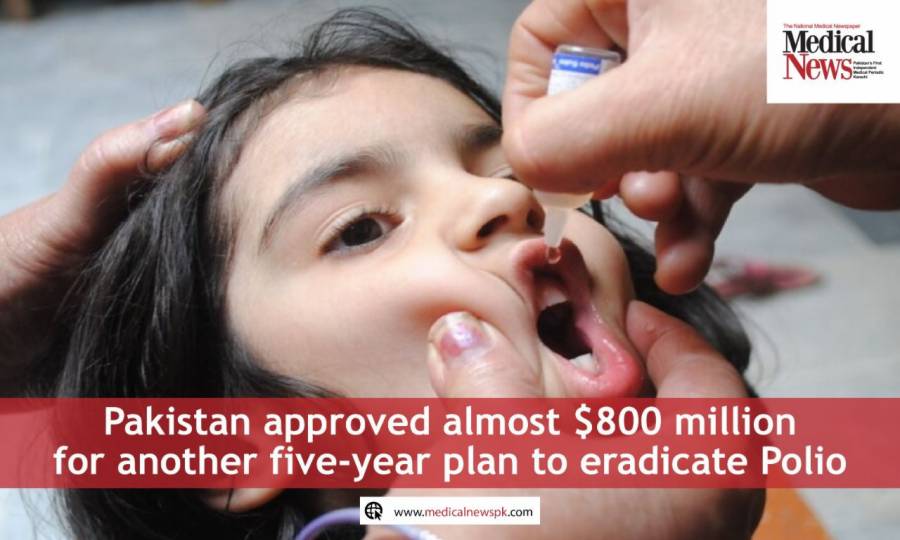Pakistan Approved Almost $800 Million for Another Five-Year Plan to Eradicate Polio

The Pakistan National Polio Laboratory at the National Institute of Health (NIH), Islamabad, verified the type-1 wild poliovirus (WPV1) in a child from North Waziristan on April 22, 2022, with paralysis beginning on April 9. They confirmed a positive environmental sample collected on April 5, 2022, from the same province's Bannu district, where an emergency action plan has already been implemented.
The concerned authorities in Pakistan remain largely unsuccessful in eliminating the crippling disease despite spending $1 billion over the past decade. Hence, the government of Pakistan, on April 11, approved almost $800 million for another five-year programme to eradicate polio.
KP Identified As Endangered Province For Wild Polio Virus
Wild poliovirus types 2 and 3 have been eradicated globally, while WPV1 cases are at a historic low. Apart from Pakistan, two other WPV1 cases have been reported this year in Afghanistan and Malawi.
In the last quarter of 2021, after wild poliovirus was discovered in environmental samples, the polio programme selected Southern Khyber-Pakhtunkhwa (KP) as the area most at risk. Meanwhile, in KP, positive wild poliovirus environmental samples were discovered in the DI Khan and Bannu divisions.
Furthermore, in 2020, the province of KP reported 22 cases, while no wild poliovirus cases were recorded in the province last year. Moreover, Pakistan had also reported one case last year with onset on January 27 2021, in Killa Abdullah, Balochistan.
"This is, of course, a tragedy for the youngster and his family, and it is also very terrible both for Pakistan and polio eradication efforts throughout the world. We are disappointed but not discouraged," Health Secretary Aamir Ashraf said of the unfortunate circumstance in North Waziristan.
Moreover, he added, "The National and Provincial Polio Emergency Operations Centres have deployed teams to conduct a full investigation of the recent case, while emergency immunisation campaigns are underway to prevent further spread of the wild poliovirus in Pakistan."
CDWP Emergency Plan For Polio Eradication Comes Up With A Promise
Pakistan has invested $986 million in polio eradication since 2010 but has yet to achieve success. Once again, Central Development Working Party (CDWP) approved the Emergency Plan worth $800 million for the Polio Eradication project for 5-year in line with the current National Emergency Action Plan for Polio Eradication 2021-23 and Global Polio Eradication Initiative strategy (GPEI) 2022-2026.
The Plan comes up with an aim to eliminate the wild polio virus and circulating vaccine-derived poliovirus type 1 (cVDPV1) across the country and achieve post-polio certification. The program also intends to limit the virus circulation to core reservoirs and shared transmission corridors and then interrupt all polio viruses within the reservoirs by 2024.
On the other hand, WHO and UNICEF charge a handsome amount as administrative expenses to the Government of Pakistan. Out of the total cost, WHO will administer the $335 million component, while the remaining cost of $465 million will be taken care of by UNICEF. However, a major part of the new $800 million projects, $129 million, will be spent on social mobilisation, including $29 million on the polio campaign.
Objectives Of The Polio Eradication Strategy 2022–2026
The Polio Eradication Strategy 2022–2026 has set clear goals for progress toward eradication. The main objectives of the five-year polio elimination strategy are
· To generate vaccine acceptance through community participation that is customised to the situation
· To expedite progress through expanded integration efforts and unified partnership
· To improve frontline success through changes to campaign and outbreak response operation
· To enhance detection and response through sensitive surveillance
· To build stronger political will, create urgency and accountability through engagement
All Eyes Now On Epidemiological Coalition To Eliminate This Fatal Illness
Pakistan remains one of only two countries globally with circulating wild poliovirus, together with Afghanistan. Polio is a highly infectious virus that primarily affects children under five. It attacks the nerve system, causing paralysis or death. However, vaccination is the most effective strategy to protect children from polio, despite having no cure.
Until this last remaining epidemiological alliance wipes out polio, children all over the world remain at risk of life-long paralysis or fatality by the polio virus.
Advertisement
Trending
Popular
Hair loss: Discovery uncovers key stem cells that could reverse ...
-
Broccoli sprout compound may help lower ...
11:31 AM, 25 Feb, 2025 -
Gas Pain vs. Heart Attack: How to tell ...
09:00 PM, 22 Feb, 2025 -
Coconut oil supplement shows promise ...
08:00 PM, 20 Feb, 2025 -
Normal vitamin B12 levels may still ...
05:00 PM, 19 Feb, 2025



